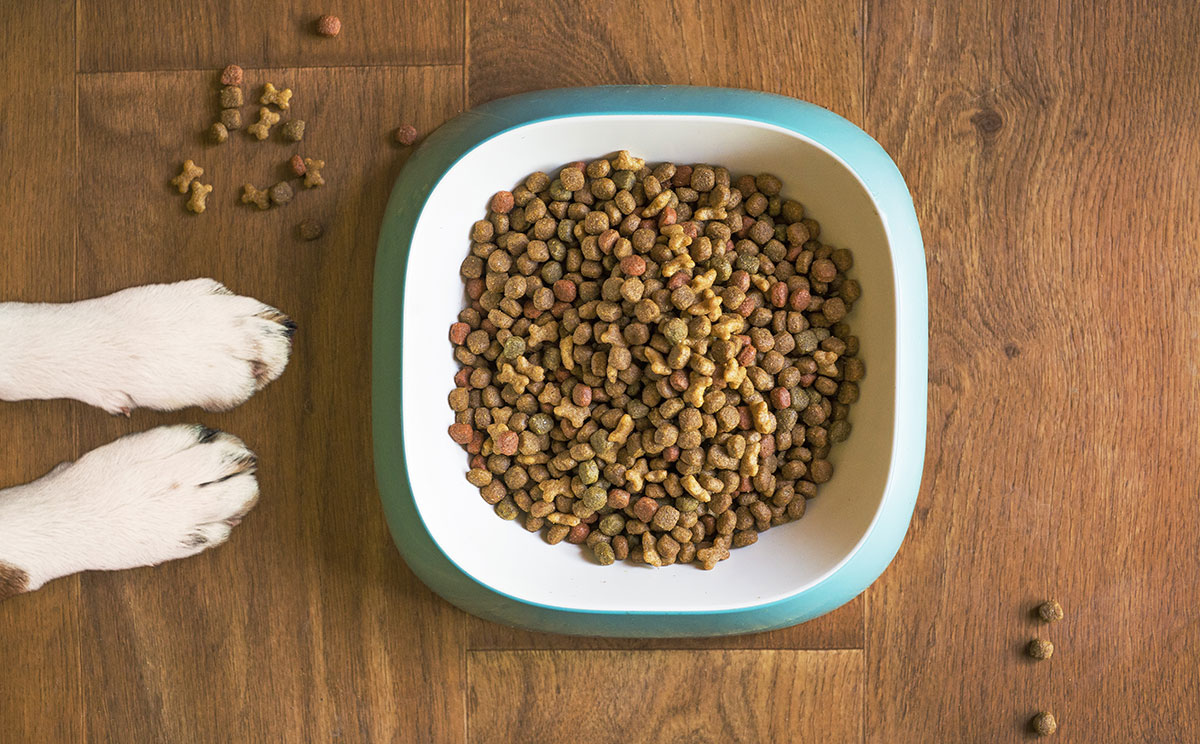 |
  
|
Should You Feed Your Dog That?Skeptoid Podcast #984  by Brian Dunning Many people tend to go in for fads that they view as fashionable, enlightened, wellness-focused, sustainable, or ethically sourced. In particular, we see uptake on these fads most in demographics that are likely to be white, well educated, and with disposable income. Many of these people are also dog owners, and so it should come as no surprise that they seek out similar fad-oriented products for their dogs. Most notably, this includes dog food. Boutique dog food manufacturers notice this, and so they have shrewdly launched dog food products intended to appeal to this precise demographic. This has given us dog food products that converge with human owners' personal diets. You will see organic, GMO-free, gluten-free, and cruelty-free emblazoned all over dog food products in stores. Today we're going to have a close look at this, and see whether human food trends target-marketed to wellness-conscious dog owners are good choices to put into their dogs' food bowls. Let's begin by understanding what a dog's nutritional needs are, and how they differ from humans. Obviously, humans are omnivores and dogs are carnivores. It's why our teeth are so different. We have incisors for cutting food; canines for tearing meat; and molars for grinding plant and animal matter. Our teeth do it all, as does our digestive system. But a dog's are much more specialized: incisors for tearing flesh; very long canines for puncturing and holding onto prey, and molars that are much sharper than ours for shearing meat rather than grinding it. These differences are also visible in our jaws. Ours can move side to side for grinding; a dog's only move up and down for biting and tearing, no grinding. From these we can infer things about a dog's digestive system. It takes a longer, slower digestive system to break down plants and grains. That's what we have. Dogs have very short intestines, optimized for processing meat. In addition to this important anatomical difference, there are many others:
Dogs aren't pure carnivores; they're what's called facultative carnivores. This means that animal flesh is their main diet, but they can also get by — to some degree — on less optimal food. Kind of like you could survive for a while on nothing but Skittles; you might not like it, and you couldn't do it forever, but you could get by. Cats, in contrast, are pure carnivores (called obligate carnivores). They can't get by on some of what a dog can; they need animal tissue. This is why cats are always killing birds and mice around your house, whereas a dog doesn't have that need. Dogs are happy to take just about any table scraps, even if they don't digest it or gain any nutrition from it; cats won't take anything but meat. And so given that a dog's food requirements are substantially different than humans, and given that your average human doesn't really know what a dog's particular nutritional needs are, it became apparent that we needed someone to figure this out. This arose in the form of the AAFCO, the Association of American Feed Control Officials, an independent nonprofit founded in 1909 to establish standards for animal feed. Any good pet food — or food for any animal — will have a Nutritional Adequacy statement, usually on the back of the bag and in small print, stating that it meets the AAFCO standards. It will tell you what species of animal it's for and at what life stage. It should also state that the food is complete and balanced: Complete means that it contains all the nutrients that animal requires, and balanced means those nutrients are present in the correct ratios. When you put the AAFCO recommendations all together, what does the perfect dog food look like? Is it organic? Is it gluten free? Is it all natural? Is it high in turmeric and antioxidant supplements? No, to all of those things. The ideal dog food is standard kibble. Kibble?? You would never feed that horrible, cardboard-looking stuff to your child; why on Earth would you ever feed it to your dog? Because those little solid kibbles contain exactly the fats and proteins and vitamins that your dog needs, and they are optimized for your dog's teeth and the way a dog's mouth and jaw works. Note that children and dogs both love peanut butter, but while your child can wolf it down, a dog can't. He sits there working his jaw for minutes. A dog's mouth does not work like a human's mouth, and that's why kibble bits are the size and shape and consistency they are. It's not to make them cheap to produce and it's not because they're made of low-quality ingredients; it's to make them easiest for your dog to consume. A few top brands that are AAFCO compliant and are also recommended by PetMD's Vet Advisory Panel are Hills®, Eukanuba™, Purina®, IAMS™, and Royal Canin®. All of these have meat protein as their main ingredient, usually chicken, sometimes supplemented with other meats. More upscale brands — and by upscale, I mean more expensive, but no better for the dog — will use more expensive meats like beef or salmon. It doesn't matter as long as they deliver the required protein. The brands all contain fat since that's so important for dogs. And to make sure the dog gets all the energy it needs, they all deliver glucose in the form of refined carbohydrates. Usually these come from whole grains such as corn or wheat, and some offer grain-free alternatives (again to appeal to humans who think their dogs are humans) such as peas, lentils, potatoes, and so on. A proper balance of these ingredients also delivers all of the vitamins and minerals that a dog requires. But dogs aren't the ones who do the shopping. People are, and some people feel those big-box brands of kibble so recommended by experts are made with cheap or unhealthy ingredients. So boutique dog food producers try to appeal to people and their food preferences. Their products are typically at a premium price, so they look into what wealthier consumers are into; and that brings us back to the things we talked about at the top of the show. All the food fads: organic, GMO-free, gluten free, sustainably sourced; and then a lot of meaningless terms like "contains no filler". Many of these have now coalesced into the current leading trend in pet food: the "human-grade" label. AAFCO actually maintains definitions on what pet foods can bear the human-grade label. By way of background, companies that manufacture, process, pack, hold, import, or export animal food products have to be licensed by the Food and Drug Administration. They have to follow all kinds of food safety regulations. All their ingredients must have the FDA's "generally recognized as safe" designation. All of this goes for human food manufacturers too, except that those are sometimes stricter; and human food facilities are more likely to get inspected than animal food facilities. So for a pet food to be labeled as human-grade, the requirement is pretty simple: every single step of that process — ingredients, manufacturing, shipping, storage, processing, importing or exporting — must be licensed by the FDA for both human food and animal food, even if they don't produce any human food (and most don't). This often isn't all that big a deal, and for a smaller boutique producer, they may accidentally meet the human licensing requirements anyway — sometimes it's just a matter of filing for the proper registrations. Some people may be quick to assume that a human-grade pet food has healthier ingredients than big-box kibble. They would be in error. They are generally the exact same ingredients, as all that anyone uses are already generally recognized as safe. The producer has just done more paperwork, and usually made modest changes to their process. It's also worthwhile to note that while all of these licensing requirements are intended mainly to protect against foodborne illnesses, of which Salmonella is the biggest fear, there is no evidence that human-grade dog food is safer than any other AAFCO compliant dog food. Recalls for Salmonella are rare for either. Where Salmonella contamination truly is a real problem is in raw dog food. Raw dog food — in fact raw pet food for any species of pet — is also commonly found contaminated with E. coli, listeria, tapeworms, and other parasites. Lots of studies have been conducted, and it turns out that most raw pet food products are contaminated with one or more of these bacteria and parasites — and zero are found in commercially available cooked kibble; and both humans and dogs have died as a result. Proponents claim that raw food is more natural for a dog's native diet. Wolves are apex predators, and nearly all of their diet consists of fresh kill that's not yet contaminated with bacteria. But in a pinch, wolves will also scavenge, finding carrion that has died from other causes. Instinctively they avoid sun-exposed carrion, which will be highly contaminated. However, a wolf's gut microbiome is adapted to this, and is filled with microbes resistant to bacteria such as E. coli and Salmonella. A wolf's digestive system is also very slow, and meat remains in their stomach for up to 12 hours, giving plenty of time for the harsh gastric environment to neutralize dangerous bacteria. But dogs are not wolves. Although they are the same species, they have been separated for thousands of years, and over that time span dogs have adapted to domestication and a diet provided by humans. Genetically today's dogs differ from wolves, as natural selection has favored dogs better able to digest carbohydrates. And their gut microbiomes have changed to accommodate the different diet as well. So all of this means that it's not true that raw dog food better matches your dog's native diet. It better matches a wolf's, but your dog is not a wolf. As a result, both the FDA and the American Veterinary Medical Association (AVMA) strongly discourage raw diets for dogs. This isn't just to protect your dogs; it's to protect your family as well. Zoonotic disease transmission carries these pathogens from your dog to you through licking, aerosols, and other direct contact — or even just handling the food. Please avoid all raw dog foods. Oh and one final note: Keep the Starbucks Puppuccinos to a minimum. Most dogs are lactose intolerant. They really love the cup of whipped cream, but it will give most dogs an upset stomach or possibly even diarrhea. It's OK in moderation, but that's where it should stay: Don't make it a daily or regular treat. Stick with dog treats that are AAFCO compliant. Your furry snuggle bunny will thank you for it.
Cite this article:
©2025 Skeptoid Media, Inc. All Rights Reserved. |